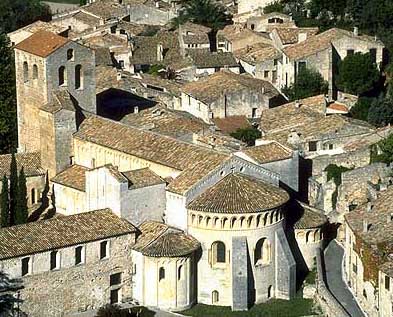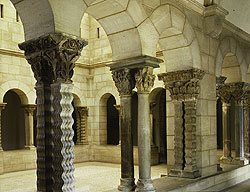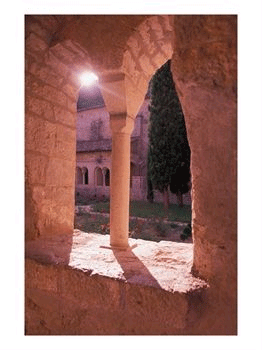
![]() Saint-Guilhem-le-Desert
is the name of an abbey and the village that grew up around it in the Gellon valley,
both named after Guilhem, a ninth century frankish prince.
Saint-Guilhem-le-Desert
is the name of an abbey and the village that grew up around it in the Gellon valley,
both named after Guilhem, a ninth century frankish prince.
The
Town and Castle
The
Abbey
St
Guilhem
Nearby
Caves
Walks
The Town of Saint-Guilhem-le-Desert

![]() The
town Saint-Guilhem-le-Désert lies in the Gellon valley just North of Gignac,
east of the new A75 motorway, about 30 kilometres Northwest of Montpellier.
It is really more of a village with a population of around 250.
The
town Saint-Guilhem-le-Désert lies in the Gellon valley just North of Gignac,
east of the new A75 motorway, about 30 kilometres Northwest of Montpellier.
It is really more of a village with a population of around 250.
The village has retained its medieval personality with old houses in amber stone, an ancient tower, and a shady square with a fountain and traditional plain trees. It sprawls organically along the Verdus stream, surrounded by cliffs, verdant with thyme, oak and pine trees. The prison tower is a vestige of the medieval village and still dominates it. It is a simple square crenelated tower, pierced by a simple window.

![]()

![]() Saint-Guilhem-le-Désert
is counted among the Plus Beaux Villages (most beautiful villages) of France,
classed, since 1999 a National Site. It is home to numerous artists, many of whom
may be found in their studios around the square.
Saint-Guilhem-le-Désert
is counted among the Plus Beaux Villages (most beautiful villages) of France,
classed, since 1999 a National Site. It is home to numerous artists, many of whom
may be found in their studios around the square.
Overlooking the village, on the side of the cliff, is a castle of Visigoth origin. It was only ever a modest fortress but has attracted colourful stories involving Visigoths, Saracens and troubadours. According to legend this castle was once the abode of a Saracen giant, called Don Juan, who was defeated in improbable circumstances by the eponymous Guilhem in single combat.

![]() Along
the gorges of the Hérault
river, between the plateaux of the CÚvennes
and Larzac and the rich vineyard plains of the Languedoc,
the tows of Aniane, Montpeyroux, Puechabon, Saint-Jean-de-Fos
and Saint-Guilhem-le-Desert, are collectively known as the
'Grand Site de Saint-Guilhem-le-Désert'. A bridge
known as the Pont du Diable has connected these five villages
since the eleventh century.
Along
the gorges of the Hérault
river, between the plateaux of the CÚvennes
and Larzac and the rich vineyard plains of the Languedoc,
the tows of Aniane, Montpeyroux, Puechabon, Saint-Jean-de-Fos
and Saint-Guilhem-le-Desert, are collectively known as the
'Grand Site de Saint-Guilhem-le-Désert'. A bridge
known as the Pont du Diable has connected these five villages
since the eleventh century.
Location & Contact

![]() Saint-Guilhem-le-Désert
is in the Canton of Aniane, Arrondissement of Montpellier,
in the Hérault
département.
Saint-Guilhem-le-Désert
is in the Canton of Aniane, Arrondissement of Montpellier,
in the Hérault
département.
Location 03° 33' 02" E 43° 44' 05"
N
Altitude 54 m - 812 m
INSEE code 34261
Postal code 34150
Michelin
map No: 339 (Grid reference: G6)
Tourism Office of Saint-Guilhem-le-Désert
and the Cave of Clamouse
2 rue Font du Portal
34150 Saint-Guilhem-le-Désert
Tel/Fax:
04 67 57 44 33
Email: ot-st-guilhem@wanadoo.fr

 The
Abbey
The
Abbey
The Abbey, located in the town of Saint-Guilhem-le-Désert in the Gellone Valley is a Benedictine foundation dedicated to Saint-Sauveur. It was founded in 804 by Guilhem of Orange, Duke of Aquitaine and of Toulouse, a member of Charlemagne's court, later known as Saint Guilhem.
It benefited financially from gullible pilgrim visitors. By the middle of the 11th century the monks were rich enough to rebuild their monastery on a larger scale. The present abbey church dates from this period.
During the 14th to 16th centuries, the abbey progressively declined. Like other French religious buildings, Saint-Guilhem suffered in the Wars of Religion. The abbey declined further in the 18th century. It was suppressed in 1790 during the French Revolution, and the buildings sold.

![]() Fragments
of the abbey may be found all over the region, and even much further away. You
can see some of those columns of the cloister dating from before 1206 in the Cloisters
museum, north of New York (part of New York's Metropolitan Museum of Art).
Fragments
of the abbey may be found all over the region, and even much further away. You
can see some of those columns of the cloister dating from before 1206 in the Cloisters
museum, north of New York (part of New York's Metropolitan Museum of Art).
Click on the following link for more on the
Abbey of Saint-Guilhem-le-Desert ![]()

![]() An important pilgrim route, the Via Tolosana (marked in blue on the right) led through Arles, St-Gilles, Saint-Guilhem-le-Désert and Toulouse and crossed the Pyrenees to join other routes at Puenta-la-Reina, thence to Santiago along the Via Compostelana to Santiago de Compostela.
An important pilgrim route, the Via Tolosana (marked in blue on the right) led through Arles, St-Gilles, Saint-Guilhem-le-Désert and Toulouse and crossed the Pyrenees to join other routes at Puenta-la-Reina, thence to Santiago along the Via Compostelana to Santiago de Compostela.
Another route, the Regordane (marked in green), led from Le Puy-en-Velay to St-Gilles, by way of the Cévennes, Alès and Nîmes. Some pilgrims came only as far as St-Gilles, the fourth most important pilgimage destination in Europe. Others went on to Santiago de Compostela along the Via Tolosana possibly taking a detour to Saintes-Maries-de-la-Mer (While Compostela claimed the relics of St-James, Saintes-Maries-de-la-Mer claimed the relics of his mother, Mary) |
|
St Guilhem

![]() William
a grandson of Charles Martel. He was born in France around the middle of the 8th
century. His mother Aldana was a daughter of Charles Martel, so he was a cousin
of Charlemagne. As a close kinsman of Charlemagne he spent his youth in the imperial
court. William was made Count of Toulouse in 790, and Charlemagne placed his young
son (Louis the Pious, who was to inherit Aquitaine), in his wardship. He was the
second count of Toulouse and held the title from 790 until 811.
William
a grandson of Charles Martel. He was born in France around the middle of the 8th
century. His mother Aldana was a daughter of Charles Martel, so he was a cousin
of Charlemagne. As a close kinsman of Charlemagne he spent his youth in the imperial
court. William was made Count of Toulouse in 790, and Charlemagne placed his young
son (Louis the Pious, who was to inherit Aquitaine), in his wardship. He was the
second count of Toulouse and held the title from 790 until 811.
The name Gilhem is Occitan, corresponding to Latin, Guilhelmus, English William, French Guillaume.
Guilhem dedicated the next thirteen years to sustaining the southern frontiers of the Frankish empire. He was renowned as one of the most valiant warriors of his time.
He married twice, his second wife the Lady of Orange apparently the widow of a Saracen Lord that he killed and whose estates he seized.
Guilhem's exploits became famous and he evolved into the hero of medieval ballads of knightly prowess and chivalry. He is the hero of the Chanson de Guillaume, an early chanson de geste, and of several later sequels.
In 804 Guilhem retired to the Abbey of Aniane. (For many centuries it was regarded as entirely laudable for men to abandon their wives and families to become monks). In 806 he headed a group of monks who set off to found the Abbey of Gellone (now Saint-Guilhem-le-Désert) .
Before his death, Charlemagne had given the young Guilhem a reliquary, which was believed to contained pieces of the True Cross. (Hundreds of such bogus relics were in circulation even before the Crusades). Guilhem left this one to his Abbey, where it remains to this day. The jewelled reliquary is carried through the village in procession once a year on the 3rd May - St Guilhem's feast day. Replicas made of biscuit are available in the Abbey Church. The faithful claim that they provide protection against lightening.
Guilhem is known by several different names, some of them reflecting his appearance, some his conquests, some his later religious life, and some merely confusion with other semi legendary Guilhems. He was Guilhem the short nosed - French Guillaume au Court Nez, or the Marquis au court nez - a disfigurement incurred during his battle with that pesky Moorish giant who lived in the castle at Gellone. He was also Guillaum de Narbonne; Guillaume Fierabrace, Guillaume d'Orange, and Guilhem de Gellone and Saint Guilhem.
According to the book Holy Blood Holy Grail Guilhem was the son of "Theodoric, king of the Jews of Septimania" crowned in 768. Through him the bloodline of Jesus became the bloodline of Frankish royalty. This fantasy was later incorporated into the plot of the best-selling novel The Da Vinci Code.
Click on the following link for more on
Guilhem ![]()
Clamouse Cave

![]()

![]()

![]() Three
kilometres from Saint-Guilhem-le-Désert, is the Clamouse Cave known for
some reason as the 'Cathedral of Time'.
Three
kilometres from Saint-Guilhem-le-Désert, is the Clamouse Cave known for
some reason as the 'Cathedral of Time'.
It is currently being inscribed as a World Heritage site by UNESCO .
Grotte de Clamouse
34150 Saint-Jean-de-Fos
Tel.
04 67 57 71 05 - Fax 04 67 57 78 00
email : grotte@clamouse.com
web site:
www.clamouse.com
Open all year
Click on the following link for more on Clamouse
and other caves and grottos in the Languedoc ![]()
Walks in the Area
There are interesting walks you can make from here.
Les Fenestrettes, A historical mule path At the heart of the Cirque du Bout-du-Monde, you will find sheer cliffs, the path of the Fenestrettes. This path links the Gellone Valley to Larzac. Constructed in the 18th century, the path is today used by pilgrims taking the Southern path towards Santiago on the Saint James Pilgrimage route. (The path was restored some years ago by prisoners).
From place de la Liberté, take rue du Bout-du-Monde out of the village and walk for about30min. Alternatively, take the zigzag 'Chemin de Grande Randonnée (GR 74), through the shrubs and flowers towards the castle ridge (which also takes about 30min). To reach the 'Max Nègre' view point, follow the path used by Pilgrims of Saint Jacques de Compostelle, which passes by 'les Fenestrelles'. This path follows the vertical cliff faces. It is steep and should be avoided in high winds. The GR 74 winds around the northern part of the Circuit, passing under the castle (the 'Château du Géant') Another branch continues along the GR74 to the Ermitage Notre-Dame-de-Belle-Grâce (90min), and on to join the GR7 at St-Maurice-Navacelles on the Causse de Larzac.
|







